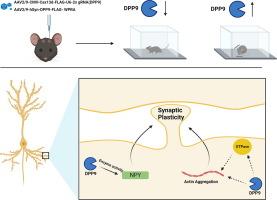Hippocampal dipeptidyl peptidase 9 bidirectionally regulates memory associated with synaptic plasticity
IF 11.4
1区 综合性期刊
Q1 MULTIDISCIPLINARY SCIENCES
引用次数: 0
Abstract
Introduction
Subtypes of the dipeptidyl peptidase (DPP) family, such as DPP4, are reportedly associated with memory impairment. DPP9 is widely distributed in cells throughout the body, including the brain. However, whether DPP9 regulates memory has not yet been elucidated.Objectives
This study aimed to elucidate the role of DPP9 in memory, as well as the underlying molecular mechanism.Methods
We performed immunofluorescence on mouse brains to explore the distribution of DPP9 in different brain regions and used AAV vectors to construct knockdown and overexpression models. The effects of changing DPP9 expression on memory were demonstrated through behavioral experiments. Finally, we used electrophysiology, proteomics and affinity purification mass spectrometry (AP-MS) to study the molecular mechanism by which DPP9 affects memory.Results
Here, we report that DPP9, which is found almost exclusively in neurons, is expressed and has enzyme activity in many brain regions, especially in the hippocampus. Hippocampal DPP9 expression increases after fear memory formation. Fear memory was impaired by DPP9 knockdown and enhanced by DPP9 protein overexpression in the hippocampus. According to subsequent hippocampal proteomics, multiple pathways, including the peptidase pathway, which can be bidirectionally regulated by DPP9. DPP9 directly interacts with its enzymatic substrate neuropeptide Y (NPY) in neurons. Hippocampal long-term potentiation (LTP) is also bidirectionally regulated by DPP9. Moreover, inhibiting DPP enzyme activity impaired both LTP and memory. In addition, AP-MS revealed that DPP9-interacting proteins are involved in the functions of dendritic spines and axons. By combining AP-MS and proteomics, DPP9 was shown to play a role in regulating actin functions.Conclusion
Taken together, our findings reveal that DPP9 affects the CNS not only through enzymatic activity but also through protein–protein interactions. This study provides new insights into the molecular mechanisms of memory and DPP family functions.

海马二肽基肽酶 9 双向调节与突触可塑性有关的记忆
导言据报道,二肽基肽酶(DPP)家族的一些亚型,如 DPP4,与记忆损伤有关。DPP9 广泛分布于包括大脑在内的全身细胞中。本研究旨在阐明DPP9在记忆中的作用及其潜在的分子机制。方法我们对小鼠大脑进行了免疫荧光,以探索DPP9在不同脑区的分布,并使用AAV载体构建了敲除和过表达模型。通过行为实验证明了改变 DPP9 表达对记忆的影响。最后,我们利用电生理学、蛋白质组学和亲和纯化质谱法(AP-MS)研究了 DPP9 影响记忆的分子机制。恐惧记忆形成后,海马 DPP9 的表达增加。在海马中敲除 DPP9 会损害恐惧记忆,而过量表达 DPP9 蛋白则会增强恐惧记忆。根据随后的海马蛋白质组学研究,包括肽酶通路在内的多种通路可受到 DPP9 的双向调控。DPP9 直接与其酶底物神经肽 Y(NPY)在神经元中相互作用。海马长期电位(LTP)也受 DPP9 的双向调节。此外,抑制 DPP 酶的活性会损害 LTP 和记忆。此外,AP-MS揭示了与DPP9相互作用的蛋白质参与了树突棘和轴突的功能。结合 AP-MS 和蛋白质组学,DPP9 被证明在调节肌动蛋白功能中发挥作用。这项研究为记忆的分子机制和 DPP 家族的功能提供了新的见解。
本文章由计算机程序翻译,如有差异,请以英文原文为准。
求助全文
约1分钟内获得全文
求助全文
来源期刊

Journal of Advanced Research
Multidisciplinary-Multidisciplinary
CiteScore
21.60
自引率
0.90%
发文量
280
审稿时长
12 weeks
期刊介绍:
Journal of Advanced Research (J. Adv. Res.) is an applied/natural sciences, peer-reviewed journal that focuses on interdisciplinary research. The journal aims to contribute to applied research and knowledge worldwide through the publication of original and high-quality research articles in the fields of Medicine, Pharmaceutical Sciences, Dentistry, Physical Therapy, Veterinary Medicine, and Basic and Biological Sciences.
The following abstracting and indexing services cover the Journal of Advanced Research: PubMed/Medline, Essential Science Indicators, Web of Science, Scopus, PubMed Central, PubMed, Science Citation Index Expanded, Directory of Open Access Journals (DOAJ), and INSPEC.
 求助内容:
求助内容: 应助结果提醒方式:
应助结果提醒方式:


